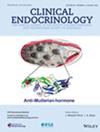Anaemia-based screening for resistance to thyroid hormone alpha in children
Abstract
Background
The hypothyroid phenotype associated with resistance to thyroid hormone alpha (RTH-α) is associated with a diverse clinical picture. On the other hand, thyroid-stimulating hormone (TSH) levels are normal. Free triiodothyronine (fT3) and free thyroxine (fT4) levels can also be normal; however, normo- or macrocytic anaemia is usually present in reported cases. Diagnosis is challenging and there is limited data regarding screening methods.
Objective
The study aimed to assess the efficiency of a screening strategy for RTH-α.
Subjects and Methods
Out of a total of 6540 children evaluated at the outpatient clinics of paediatric neurology over 2 years and who underwent complete blood count and thyroid function tests, 432 were found to have anaemia. Within this group, we identified 42 children without an underlying specific neurological aetiology who exhibited normo- or macrocytic anaemia, normal TSH levels, fT3 levels in the upper half of the normal range or high, and fT4 levels in the lower half of the normal range or low. We excluded one patient who had already been diagnosed with RTH-α and nine patients could not be reached. Subsequently, clinical evaluation, biochemical assessment, and THRA sequencing analysis were conducted on 32 children. The findings were compared with those of the known RTH-α patients in our unit.
Results
The median age of the patients was 5.7 (5.1–7.4) years, and 22 of them were males (69%). The main reasons for assessment in paediatric neurology clinics were autism spectrum disorder (n = 12, 38%), epilepsy (n = 11, 34%), and delay in developmental stages (n = 8, 25%). Constipation was present in five of the cases (16%), while the closure of the anterior fontanelle and tooth eruption were delayed in two cases (6%) and one case (3%), respectively. The median length/height and weight standard deviation (SD) scores were 0.3 [(−0.8)–(1.1)] and −0.1 [(−0.8)–(0.3)], respectively. The median fT3, fT4, and TSH levels were 4.6 (4.2–5.0) pg/mL, 0.9 (0.8–1.0) ng/dL, and 2.2 (1.8–3.1) uIU/mL, respectively. Thirteen of the patients (41%) had high fT3 levels, while none of them had low fT4 levels. The normo- or macrocytic anaemia rate was 47% (normocytic/macrocytic, n = 8/7) at the time of reassessment. Serum creatine kinase (CK) was elevated in five patients (16%; one had anaemia). None of the subjects had a pathological variant in THRA. Known RTH-α patients had significantly lower median height SD score, higher rates of delayed tooth eruption and closure of the anterior fontanelle, lower haemoglobin levels, and higher mean corpuscular volume (MCV) and CK levels as compared to those found without RTH-α.
Conclusions
This approach found one known patient with RTH-α but did not reveal any new cases. Notably, normo- or macrocytic anaemia did not persist in nearly half of the screened patients. A screening strategy that takes clinical findings and prominent laboratory features suggestive of RTH-α into account could lower unnecessary genetic analysis of THRA in patients presenting with neurological problems.

| 公司名称 | 产品信息 | 采购帮参考价格 |
|---|
 求助内容:
求助内容: 应助结果提醒方式:
应助结果提醒方式:


